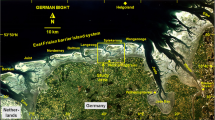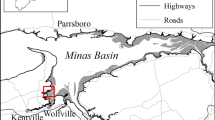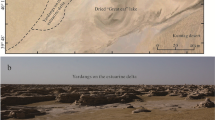Abstract
The routine sampling procedure for grain-size analysis of intertidal heterolithic deposits runs a high risk of inadvertent mixing of two or more different sedimentation units, which would consequently complicate data interpretation. Traditionally, sedimentologists pay less attention to muddy layers due to a lack of internal structures, although the grain-size populations of such layers should encode more information on fine-mud flocculation processes than sandy layers. In this paper, individual muddy and sandy layers of nine short cores from the Da-Jian-Shan tidal flats of the middle Qiantang Estuary in the East China Sea, which experiences tidal bores, were sampled separately for grain-size analysis. A core taken at Huang-Jia-Yan from the lower estuary, not affected by tidal bores, served for comparison. A curve-fitting method was employed to decompose each grain-size distribution into two Gaussian populations. Cumulative plots indicate that intertidal sediments are mostly dispersed as intermittent and uniform suspension loads, traction loads being absent or very subordinate. This is conceivably linked to flows agitated by tidal bores, and to the highly dynamic nature of fine sand and coarse silt particles. Selective transport and deposition have produced three distinct sedimentation units, namely, tidal-bore deposits, tidal sandy deposits, and tidal muddy deposits. These can also be discriminated on bivariate plots of any two textural parameters. Shoreward attenuation of tidal flows is reflected in the gradual fining and thinning of sandy layers from lower-flat massive sands, through middle-flat hybrid deposits (alternations of massive sands and tidal rhythmites), to upper-flat tidal rhythmites. This gradient is also well represented in slightly decreasing (increasing) sorting and decreasing (increasing) proportions of the coarser (finer) hydraulic populations in the muddy layers. Although no corresponding trends are discernible in the hydraulic populations of the sandy layers, these can be distinguished on the basis of characteristic sedimentary structures. The floc limit and floc volume fraction, estimated from the modes and proportions of the finer hydraulic populations, are 8~10 μm (16 μm) and on average 41.73% (26.41%) for muddy (sandy) layers, respectively. The most plausible explanation is that the floc limit sensitively responds to subtle changes in the suspended sediment composition and the ambient hydraulic and hydrochemical settings. In comparison, the Huang-Jia-Yan core features blurred bedding and higher contents of fine mud and flocs, these being consistent with the weaker energy on the upper tidal flat of the lower estuary where neither tidal bores nor bigger waves occur.










Similar content being viewed by others
References
Bartholdy J, Christiansen C, Pedersen JBT (2007) Comparing spatial grain-size trends inferred from textural parameters using percentile statistical parameters and those based on the log-hyperbolic method. Sediment Geol 202:436–452
Barusseau JP (2011) Influence of mixtures of grain-size populations on the parametric and modal characteristics of coastal sands (Hérault, Mediterranean Sea, France). J Sediment Res 81:611–629
Bein A, Sass E (1978) Analysis of log-probability plots of recent Atlantic sediments and its analogy with simulated mixtures. Sedimentology 25:575–581
Chang TS, Flemming BW (2013) Ripples in intertidal mud—a conceptual explanation. Geo-Mar Lett 33:449–461. doi:10.1007/s00367-013-0339-x
Chang TS, Flemming BW, Bartholomä A (2007) Distinction between sortable silts and aggregated particles in muddy intertidal sediments of the East Frisian Wadden Sea, southern North Sea. Sediment Geol 202:453–463
Chen J, Liu C, Zhang C, Walker HJ (1990) Geomorphological development and sedimentation in Qiantang Estuary and Hangzhou Bay. J Coast Res 6:559–572
Curran KJ, Hill PS, Schell TM, Milligan TG, Piper DJW (2004) Inferring the mass fraction of floc-deposited mud: application to fine-grained turbidites. Sedimentology 51:927–944
Davis RA Jr, Dalrymple RW (eds) (2012) Principles of tidal sedimentology. Springer, Dordrecht
Fan D, Li C (2002) Rhythmic deposition on mudflats in the mesotidal Changjiang estuary, China. J Sediment Res 72:543–551
Fan D, Guo Y, Wang P, Shi JZ (2006) Cross-shore variations in morphodynamic processes of an open-coast mudflat in the Changjiang Delta, China: with an emphasis on storm impacts. Cont Shelf Res 26:517–538
Fan D, Cai G, Shang S, Wu Y, Zhang Y, Gao L (2012) Sedimentation processes and sedimentary characteristics of tidal bores along the north bank of the Qiantang Estuary. Chinese Sci Bull 57:1157–1167
Fan D, Tu J, Cai G, Shang S (2014) Characteristics of tidal-bore deposits and facies associations in the Qiantang Estuary, China. Mar Geol 348:1–14
Fan D, Tu J, Shang S, Chen L, Zhang Y (2015) Morphodynamics and sedimentary facies in a tidal-fluvial transition with tidal bores (the middle Qiantang Estuary, China). In: Tessier B (ed) IAS Spec Publ 48 (in press)
Flemming BW (1988) Process and pattern of sediment mixing in a microtidal coastal lagoon along the west coast of South Africa. In: de Boer PL, van Gelder A, Nio SD (eds) Tide-influenced sedimentary environments and facies. D Reidel, Dordrecht, pp 275–288
Flemming BW (2007) The influence of grain-size analysis methods and sediment mixing on curve shapes and textural parameters: implications for sediment trend analysis. Sediment Geol 202:425–435
Flemming BW, Bartholomä A (eds) (1995) Tidal signatures in modern and ancient sediments. IAS Spec Publ 24. Blackwell Science, Oxford
Folk RL, Ward WC (1957) Brazos River bar: a study in the significance of grain size parameters. J Sediment Petrol 27:3–26
Friedman GM (1967) Dynamic processes and statistical parameters compared for size frequency distributions of beach and river sands. J Sediment Petrol 37:327–354
Friedman GM, Johnson KG (1982) Exercises in sedimentology. Wiley, New York
Gao S, Collins MB (2014) Holocene sedimentary systems on continental shelves. Mar Geol 352:268–294
Hajek EA, Huzurbazar SV, Mohrig D, Lynds RM, Heller PL (2010) Statistical characterization of grain-size distributions in sandy fluvial systems. J Sediment Res 80:184–192
Han Z, Dai Z, Li G (2003) Regulation and exploitation of Qiantang River Estuary (in Chinese with English abstract). China Water Publication, Beijing
Hartmann D, Bowman D (1993) Efficiency of the log-hyperbolic distribution – a case study: pattern of sediment sorting in a small tidal-inlet – Het Zwin, The Netherlands. J Coast Res 9:1044–1053
Hartmann D, Flemming B (2007) From particle size to sediment dynamics: an introduction. Sediment Geol 202:333–336
Hill SH, McLaren P (2001) A comparison between log-hyperbolic and model-independent grain-size distribution in sediment trend analysis. J Coast Res 17:931–935
Hill PS, Newgard JP, Law BA, Milligan TG (2013) Flocculation on a muddy intertidal flat in Willapa Bay, Washington, Part II: observations of suspended particle size in a secondary channel and adjacent flat. Cont Shelf Res 60(supplement):S145–S156
Kondolf GM, Adhikari A (2000) Weibull vs. log-normal distributions for fluvial gravels. J Sediment Res 70:456–460
Konert M, Vandenberghe J (1997) Comparison of laser grain size analysis with pipette and sieve analysis: a solution for the underestimation of the clay fraction. Sedimentology 44:523–535
Kranck K (1973) Flocculation of suspended sediment in the sea. Nature 246:348–350
Law BA, Milligan TG, Hill PS, Newgard J, Wheatcroft RA, Wiberg PL (2013) Flocculation on a muddy intertidal flat in Willapa Bay, Washington, Part I: a regional survey of the grain size of surficial sediments. Cont Shelf Res 60(supplement):S136–S144
Le Roux JP, Rojas EM (2007) Sediment transport patterns determined from grain size parameters: overview and state of the art. Sediment Geol 202:473–488
McCave IN, Manighetti B, Robinson SG (1995) Sortable silt and fine sediment size/composition size slicing: parameters for palaeocurrent speed and palaeoceanography. Paleoceanography 10:593–610
McCave IN, Hall IR, Bianchi GG (2006) Laser vs. settling velocity differences in silt grain size measurements: estimation of palaeocurrent vigour. Sedimentology 53:919–928
Milligan TG, Hill PS, Law BA (2007) Flocculation and the loss of sediment from the Po River plume. Cont Shelf Res 27:309–321
Molinaroli E, Guerzoni S, De Falco G, Sarretta A, Cucco A, Como S, Simeone S, Perilli A, Magni P (2009) Relationships between hydrodynamic parameters and grain size in two contrasting transitional environments: the Lagoons of Venice and Cabras, Italy. Sediment Geol 219:196–207
Passega R (1964) Grain size representation by CM patterns as a geological tool. J Sediment Petrol 3:830–847
Reineck HE, Singh IB (1980) Depositional sedimentary environments, 2nd edn. Springer, New York
Shi JZ (2010) Tidal resuspension and transport processes of fine sediment within the river plume in the partially-mixed Changjiang River estuary, China: a personal perspective. Geomorphology 121:133–151
Shields A (1936) Application of similarity principles and turbulence research to bed-load movements (in German). Mitteilungen der Preussischen Versuchsanstalt für Wasserbau und Schiffbau, Berlin, Heft 26:3–26
Shih SM, Komar PD (1994) Sediments, beach morphology and sea cliff erosion within an Oregon coast littoral cell. J Coast Res 10:144–157
Sun D, Bloemendal J, Rea DK, Vandenberghe J, Jiang F, An Z, Su R (2002) Grain-size distribution function of polymodal sediments in hydraulic and aeolian environments, and numerical partitioning of the sedimentary components. Sedimentology 152:263–277
Viard JP, Breyer JA (1979) Description and hydraulic interpretation of grain size cumulative curves from the Platte River system. Sedimentology 26:427–439
Visher GS (1969) Grain size distribution and depositional processes. J Sediment Petrol 39:1074–1106
Weltje GJ, Prins MA (2007) Genetically meaningful decomposition of grain-size distributions. Sediment Geol 202:409–424
Weltje GJ, Roberson S (2012) Numerical methods of integrating particle-size frequency distributions. Comput Geosci 44:156–167
Yu Q, Wang Y, Gao S, Flemming B (2012) Modeling the formation of a sand bar within a large funnel-shaped, tide-dominated estuary: Qiantangjiang Estuary, China. Mar Geol 299:63–76
Zhang G, Li C (1996) The fills and stratigraphic sequences in the Qiantangjiang incised paleovalley, China. J Sediment Res 66:406–414
Acknowledgements
This study was supported by the National Natural Science Foundation of China (NSFC) under grant numbers 41276045 and 41476031, the China Geological Survey (GZH201100203), and the Special Research Fund for the Doctor Program of Higher Education in China (20130072130003). We wish to thank Yijing Wu and Lingling Chen for their assistance in the field and with laboratory work. We also express our appreciation to two anonymous reviewers and the journal editors for their constructive suggestions on a previous version of the paper.
Author information
Authors and Affiliations
Corresponding author
Rights and permissions
About this article
Cite this article
Fan, D., Shang, S., Cai, G. et al. Distinction and grain-size characteristics of intertidal heterolithic deposits in the middle Qiantang Estuary (East China Sea). Geo-Mar Lett 35, 161–174 (2015). https://doi.org/10.1007/s00367-015-0398-2
Received:
Accepted:
Published:
Issue Date:
DOI: https://doi.org/10.1007/s00367-015-0398-2




